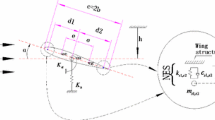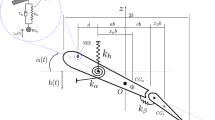Abstract
Numerical simulations were conducted to study flow-induced vibration of a two-dimensional airfoil with two nonlinear energy sinks (NES). The relationship between targeted energy transfer (TET) and vibration suppression is analyzed in detail. The main system has two degrees of freedom – the pitch and heave. The two NES are treated as subsystems, in which the first NES is place at the leading edge and the second NES is placed at the trailing edge. The limit cycle oscillation (LCO), which is to be suppressed by the NES, is studied from the viewpoint of the TET. The resonance capture (RC) in the coupled nonlinear system is also discussed by the means of the energy and spectrum analysis. This is followed by a detailed target energy transfer discussion of the heave and pitch modes and the NES. In addition, the empirical mode decomposition (EMD) is utilized to obtain an intrinsic mode function (IMF) to analyze resonance capture in the system. The results show that the NES can absorb vigorous amount of energy from one of the specified vibration modes. As the RC occurs, the TET between the vibration modes in the coupled system becomes more significant. In particular, the TET between the NES and the wing becomes more efficient. This results in an increase in the critical freestream velocity as the NES suppresses the nonlinear vibration of the main system in a very effective way. As the total energy exceeds the suppression range of the subsystem, the NES loses its effectiveness on vibration suppression effect on the main system. The IMF of the EMD exhibits special super-harmonic resonance and frequency competition characteristics.
Similar content being viewed by others
References
E.F. Sheta, V.J. Harrand, D.E. Thompson, T.W. Strganac, J. Aircr. 39, 133 (2002)
S. Singh, M. Brenner, Nonlinear Dyn. 31, 435 (2003)
C. Denegri, J. Aircr. 37, 761 (2000)
R. Bunton, C. Denegri, J. Aircr. 37, 916 (2000)
J. Croft, Aviation Week Space Technol. 155, 41 (2001)
G. Kerschen, Y.S. Lee, A.F. Vakakis, SIAM J. Appl. Math. 66, 648 (2006)
M. Kurt, I. Slavkin, M. Eriten, D.M. McFarland, O.V. Gendelman, L.A. Bergman, A.F. Vakakis, Arch. Appl. Mech. 84, 1189 (2014)
Y. Starosvetsky, O. Gendelman, J. Sound Vib. 329, 1836 (2010)
D. Quinn, R. Rand, J. Bridge, Nonlinear Dyn. 8, 1 (1995)
D. Quinn, Nonlinear Dyn. 14, 309 (1997)
D. Quinn, Int. J. Non-Linear Mech. 32, 1193 (1997)
S. Fatimah, F. Verhulst, Nonlinear Dyn. 31, 275 (2003)
Y. Liu, K.L. Li, J.Z. Zhang, Commun. Nonlinear Sci. Numer. Simul. 17, 3427 (2012)
O.V. Gendelman, D.V. Gorlov, L.I. Manevitch, A.I. Musienko, J. Sound Vib. 286, 1 (2005)
Y.S. Lee, A.F. Vakakis, L.A. Bergman, D.M. McFarland, G. Kerschen, Triggering mechanisms of limit cycle oscillations in a two degree-of-freedom wing flutter model, in Asme International Design Engineering Technical Conferences and Computers and Information in Engineering Conference, 2005, pp. 1863–1872
Y.S. Lee, A.F. Vakakis, L.A. Bergman, D. Michael McFarland, Struct. Control Health Monit. 13, 41 (2005)
Y.S. Lee, G. Kerschen, A.F. Vakakis, P. Panagopoulos, L. Bergman, D.M. McFarland, Physica D 204, 41 (2005)
M. Leonid, K. Agnessa, Phys. Rev. E 87, 304 (2012)
S.A. Hubbard, D.M. McFarland, L.A. Bergman, A.F. Vakakis, G. Andersen, AIAA J. 52, 2633 (2014)
S.A. Hubbard, R.L. Fontenot, D.M. McFarland, P.G. Cizmas, L.A. Bergman, T.W. Strganac, A.F. Vakakis, J. Aircr. 51, 1467 (2014)
Y. Lee, A. Vakakis, L. Bergman, D.M. McFarland, G. Kerschen, AIAA J. 45, 693 (2012)
Y.C. Zhang, X.R. Kong, H.L. Zhang, J. Vib. Shock 31, 150 (2012)
Y.C. Zhang, X.R. Kong, Z.X. Yang, H.L. Zhang, J. Vib. Eng. 24, 111 (2011)
E.H. Dowell, J. Mech. Des. 103, 465 (1995)
Y.A. Kuznetsov, Elements of applied bifurcation theory (Springer-Verlag, New York, 1995)
J.Z. Zhang, The stability, bifurcation theory and application of nonlinear dynamic system (Xi’an Jiaotong University Press, Xi’an, 2010)
N.E. Huang, Z. Shen, S.R. Long, M.C. Wu, H.H. Shih, Q. Zheng, N.C. Yen, C.C. Tung, H.H. Liu, Proc. R. Soc. London Ser. A 454, 903 (1998)
Author information
Authors and Affiliations
Corresponding author
Rights and permissions
About this article
Cite this article
Zhang, W., Fang, J., He, Y. et al. Resonance capture and targeted energy transfer for suppressing aeroelastic instability of 2-D wing. Eur. Phys. J. Spec. Top. 228, 1873–1889 (2019). https://doi.org/10.1140/epjst/e2019-800227-1
Received:
Revised:
Published:
Issue Date:
DOI: https://doi.org/10.1140/epjst/e2019-800227-1




